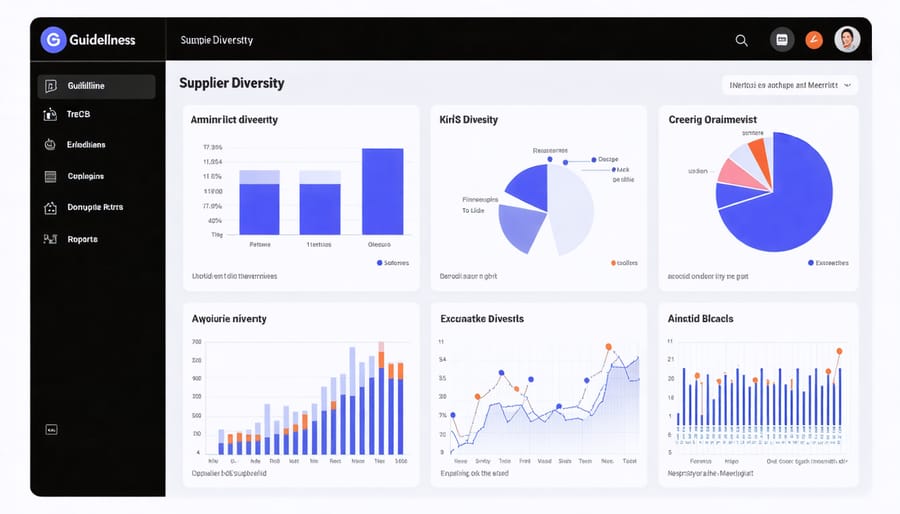Transform Your Supply Chain with Smart Diverse Supplier Programs That Drive Growth

Diverse supplier programs transform supply chains into powerful engines of economic inclusion while driving innovation and competitive advantage. By partnering with businesses owned by minorities, women, veterans, LGBTQ+ individuals, and people with disabilities, organizations unlock access to unique perspectives, specialized capabilities, and untapped market opportunities. These initiatives align perfectly with modern sustainable business practices while delivering measurable bottom-line benefits.
Research shows companies with robust supplier diversity programs enjoy 133% greater return on procurement investments and are 70% more likely to capture new markets. Leading organizations like Microsoft, IBM, and Johnson & Johnson attribute significant revenue growth and operational improvements to their supplier diversity initiatives, demonstrating the tangible business value these programs deliver.
For businesses ready to harness these advantages, implementing a diverse supplier program requires strategic planning, clear metrics, and automated processes to identify, qualify, and integrate diverse vendors into existing supply chains. The key is creating a systematic approach that balances compliance requirements with business objectives while fostering genuine partnerships that drive mutual growth.

What Makes a Diverse Supplier Program Successful?
Clear Goals and Metrics
A successful diverse supplier program requires clearly defined goals and measurable metrics to track progress and demonstrate value. Start by establishing specific, quantifiable objectives such as increasing diverse supplier spend by a certain percentage, expanding your supplier database with qualified diverse businesses, or achieving specific certification requirements.
Key metrics to monitor include:
– Total spend with diverse suppliers
– Percentage of diverse suppliers in your supply chain
– Number of new diverse supplier relationships established
– Economic impact on local communities
– Return on investment from diverse supplier partnerships
– Supplier performance and quality metrics
Implement a robust tracking system to collect and analyze these metrics regularly. Consider using automated reporting tools to streamline data collection and generate real-time insights. Set quarterly and annual benchmarks to measure progress, and regularly review these metrics with stakeholders to ensure alignment with overall business objectives.
Remember to document both quantitative and qualitative outcomes, including success stories and challenges overcome. This comprehensive approach to goal-setting and measurement helps demonstrate the program’s impact and guides continuous improvement efforts.
Supplier Qualification Process
The supplier qualification process begins with establishing clear criteria for diverse supplier certification. Potential suppliers must provide documentation proving their diversity status, such as certification from recognized organizations like the National Minority Supplier Development Council (NMSDC) or Women’s Business Enterprise National Council (WBENC).
Once certification is verified, evaluate suppliers based on their operational capabilities, financial stability, and quality standards. This typically involves a comprehensive assessment that includes:
1. Financial health review
2. Quality management systems evaluation
3. Production capacity assessment
4. Compliance verification
5. Performance track record analysis
Implement a standardized scoring system to objectively evaluate each supplier. Consider using supplier management software to streamline this process and maintain detailed records. Regular audits and performance reviews should be conducted to ensure ongoing compliance and quality standards.
Create a feedback loop with suppliers to address any issues promptly and maintain open communication channels. This helps build stronger relationships and ensures continuous improvement in supplier performance. Remember to document all evaluation steps and maintain updated supplier profiles for future reference.
Building Sustainable Partnerships Through Diversity
Innovation and Market Access
A diverse supplier program brings invaluable perspectives and innovations that drive modern business success through enhanced market access and competitive advantages. When organizations engage with suppliers from various backgrounds, they gain unique insights into different market segments and cultural nuances that can inform product development and service delivery.
These diverse perspectives often lead to creative problem-solving approaches and innovative solutions that might otherwise be overlooked. Suppliers from different communities bring their distinct experiences and understanding of various market needs, helping businesses tap into new customer bases and expand their market reach.
Furthermore, diverse suppliers often operate in underserved markets, providing companies with direct access to these growing consumer segments. This connection enables businesses to better understand and serve these markets while developing culturally relevant products and services. The resulting innovations can lead to increased market share and improved customer satisfaction across different demographic groups.
Companies with robust diverse supplier programs also benefit from increased agility in their supply chains. Different suppliers bring varied approaches to logistics, manufacturing, and service delivery, creating multiple pathways for meeting business objectives. This diversity in the supply chain helps organizations better navigate market changes and maintain competitive advantages through enhanced flexibility and adaptability.

Risk Management and Resilience
A robust diverse supplier program significantly enhances supply chain resilience by reducing dependency on single-source suppliers and geographic regions. When businesses cultivate relationships with various suppliers across different demographics and locations, they create multiple procurement channels that can help maintain operations during disruptions.
This diversification strategy proves particularly valuable during global challenges, as demonstrated during recent supply chain disruptions. Companies with established diverse supplier programs often maintain stronger supply chain continuity compared to those relying on limited supplier networks.
Diverse suppliers frequently bring innovative solutions and alternative approaches to challenges, adding flexibility to your supply chain. Their unique perspectives and different operational methods can provide backup options when traditional suppliers face difficulties. Additionally, smaller diverse suppliers often demonstrate greater agility in adapting to market changes and responding to urgent needs.
To maximize risk management benefits, implement these key strategies:
– Regularly assess supplier capabilities and financial health
– Maintain relationships with multiple suppliers in critical categories
– Develop contingency plans with diverse suppliers
– Create clear communication channels for rapid response
– Monitor supplier performance metrics consistently
By integrating diverse suppliers into your risk management strategy, you create a more adaptable and resilient supply chain that can weather market volatility and unexpected challenges while maintaining operational efficiency.
Digital Tools for Managing Diverse Supplier Programs
Supplier Management Platforms
Modern supplier management platforms have revolutionized how businesses track and engage with diverse suppliers. These digital tools streamline supplier registration, certification verification, and performance monitoring while providing real-time analytics for better decision-making. Similar to digital solutions for sustainability, these platforms help organizations achieve their diversity goals efficiently.
Key features typically include supplier portals for easy documentation submission, automated certification tracking, and customizable reporting dashboards. Many platforms also offer integrated communication tools that facilitate direct engagement with suppliers and stakeholders. This technological approach reduces manual processes and minimizes errors in supplier data management.
Look for platforms that offer:
– Automated certification renewal alerts
– Spend tracking and analysis
– Supplier discovery and matching capabilities
– Performance metrics and scorecards
– Integration with existing procurement systems
When selecting a platform, consider your organization’s size, budget, and specific diversity goals. Many solutions offer scalable options that can grow with your program, ensuring long-term sustainability and success in your supplier diversity initiatives.
Performance Monitoring Systems
Modern performance monitoring systems play a crucial role in tracking and evaluating the success of diverse supplier programs. Key performance indicators (KPIs) can be monitored through specialized supplier management software, which provides real-time data on spending patterns, supplier participation rates, and program impact.
These digital tools often feature customizable dashboards that display metrics such as total diverse spend, percentage of diverse suppliers in the supply chain, and certification status tracking. Many platforms also integrate automated reporting capabilities, making it easier to generate compliance documents and stakeholder updates.
Advanced analytics tools help organizations identify trends, spot areas for improvement, and measure the economic impact of their supplier diversity initiatives. Some systems can track tier-2 supplier diversity spending, providing a more comprehensive view of the program’s reach.
For effective monitoring, businesses should focus on both quantitative metrics (spending data, number of diverse suppliers) and qualitative indicators (supplier satisfaction, program feedback). Regular performance reviews using these systems help ensure program objectives are met and facilitate data-driven decision-making for continuous improvement.

Implementation Strategies That Work
Implementing a successful diverse supplier program requires a systematic approach and ongoing commitment. Start by establishing clear goals and metrics that align with your organization’s overall objectives. Define specific targets for supplier diversity, such as percentage of spend or number of diverse suppliers, and ensure these goals are measurable and time-bound.
Create a dedicated team or assign responsibility to existing staff members who will oversee the program. This team should develop comprehensive supplier evaluation criteria that maintain quality standards while promoting diversity. Implement a supplier registration portal where diverse businesses can easily submit their credentials and certifications.
Build relationships with certification organizations and diversity councils to access their networks of qualified suppliers. These partnerships can provide valuable resources and help validate supplier credentials. Additionally, attend supplier diversity events and trade shows to connect with potential vendors and stay current with industry trends.
Develop a structured onboarding process for new diverse suppliers, including clear communication channels and expectations. Utilize supplier management software to track performance metrics, certifications, and compliance requirements. This automation streamlines processes and ensures consistent evaluation across all suppliers.
Regular training for procurement teams is essential to address unconscious bias and promote inclusive purchasing practices. Create guidelines that encourage considering diverse suppliers in all procurement decisions while maintaining focus on quality, cost, and reliability.
Establish mentor-protégé programs to help diverse suppliers grow their capabilities and better serve your organization’s needs. This approach to building trust through sustainability creates long-term value for both parties.
Monitor and report program progress regularly using key performance indicators (KPIs). Share success stories and challenges with stakeholders to maintain engagement and support. Consider implementing a tier-2 program where primary suppliers are encouraged to work with diverse businesses, expanding the program’s impact.
Finally, regularly review and update your program based on feedback and results. Stay flexible and be prepared to adjust strategies as needed to achieve your diversity goals while maintaining business efficiency and effectiveness.
Implementing a diverse supplier program is more than just a corporate responsibility initiative – it’s a strategic business decision that can drive innovation, enhance market competitiveness, and create lasting economic impact. By embracing supplier diversity, organizations can tap into new perspectives, access unique solutions, and build stronger relationships with their communities while meeting evolving customer expectations.
Success in supplier diversity requires a committed approach, combining clear goals, robust processes, and modern technology solutions. Start by establishing measurable objectives, developing comprehensive supplier evaluation criteria, and implementing digital tools to streamline program management. Regular monitoring and reporting will help track progress and identify areas for improvement.
Remember that building a successful diverse supplier program is an ongoing journey. Begin with small, achievable steps and gradually expand your initiatives as your program matures. Engage stakeholders across your organization, from procurement teams to executive leadership, to ensure broad support and sustainable implementation.
Take action today by assessing your current supplier base, identifying opportunities for diversity, and developing a structured plan for program implementation. The benefits of a well-executed diverse supplier program – from enhanced innovation to improved brand reputation and increased market share – make it a worthwhile investment for forward-thinking organizations committed to sustainable growth and social impact.
Leave a Reply